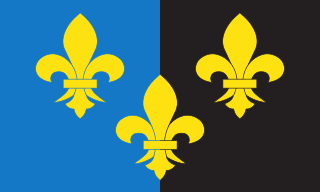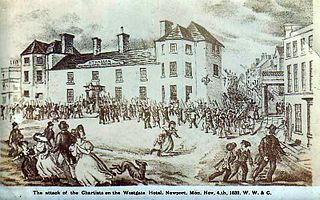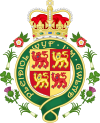Background
The first mayor is recorded as Ralph Dery, who took up office in 1314. The role was then left unrecorded until 1401, when Roger Thomas held office. [1]
One of the most famous mayors of Newport was the Chartist John Frost in 1836, who less than four years later was condemned to death for treason for his involvement in the Newport Rising. Thomas Phillips was appointed mayor in 1838 and knighted for his efforts in quelling the Rising. Frost's sentence was later commuted to transportation for life to Australia. In 1856 John Frost was given a full pardon, returned to the UK and lived in Bristol.
Several mayors have, over the years, held office for more than one term. Henry John Davis was mayor from 1851 to 1852, 1891-1892 (the first of the new County Borough) [2] and 1901–1902, having served on the Borough Council continuously for 60 years. [3]

John Frost was a prominent leader of the British Chartist movement in the Newport Rising.
Local government in Wales is primarily undertaken by the twenty-two principal councils. The councils are unitary authorities, meaning they are responsible for providing local government services within their principal area, including education, social work, environmental protection, and most highway maintenance. The principal areas are divided into communities, most of which have an elected community council. The services provided by community councils vary, but they will typically maintain public spaces and facilities. Local councils in Wales are elected; the most recent local elections in Wales took place in 2022, and the next are due to take place in 2027.

Newport is a city and county borough in Wales, situated on the River Usk close to its confluence with the Severn Estuary, 12 mi (19 km) northeast of Cardiff. The population grew considerably between the 2011 and the 2021 census, rising from 145,700 to 159,587, the largest growth of any unitary authority in Wales. Newport is the third-largest principal authority with city status in Wales, and sixth most populous overall. Newport became a unitary authority in 1996 and forms part of the Cardiff-Newport metropolitan area, also known as the Cardiff Capital Region.

Newport City Council is the governing body for Newport, one of the principal areas of Wales. It consists of 51 councillors, who represent the city's 20 wards.

Until 1974, Monmouthshire, also formerly known as the County of Monmouth, was an administrative county in the south-east of Wales, on the border with England, and later classed as one of the thirteen historic counties of Wales. Its area now corresponds approximately to the present principal areas of Monmouthshire, Blaenau Gwent, Newport and Torfaen, and those parts of Caerphilly and Cardiff east of the Rhymney River.

West Glamorgan is a former administrative county in South Wales. It is now a preserved county.

Politics of England forms the major part of the wider politics of the United Kingdom, with England being more populous than all the other countries of the United Kingdom put together. As England is also by far the largest in terms of area and GDP, its relationship to the UK is somewhat different from that of Scotland, Wales or Northern Ireland. The English capital London is also the capital of the UK, and English is the dominant language of the UK. Dicey and Morris (p26) list the separate states in the British Islands. "England, Scotland, Northern Ireland, the Isle of Man, Jersey, Guernsey, Alderney, and Sark.... is a separate country in the sense of the conflict of laws, though not one of them is a State known to public international law." But this may be varied by statute.

The Newport Rising was the last large-scale armed rising in Wales, by Chartists whose demands included democracy and the right to vote with a secret ballot.

A community is a division of land in Wales that forms the lowest tier of local government in Wales. Welsh communities are analogous to civil parishes in England. There are 878 communities in Wales.
A community council is a public representative body in Great Britain.

In the United Kingdom (UK), each of the electoral areas or divisions called constituencies elects one member to the House of Commons.

The Representation of the People Act 1948 was an Act of the Parliament of the United Kingdom that altered the law relating to parliamentary and local elections. It is noteworthy for abolishing plural voting for parliamentary elections, including by the abolition of the twelve separate university constituencies; and for again increasing the number of members overall, in this case to 613.

The City and County of Swansea Council, or simply Swansea Council, is the local authority for the city and county of Swansea, one of the principal areas of Wales. The principal area also includes rural areas to the north of the built-up area of Swansea and the Gower Peninsula to the west. The council consists of 75 councillors representing 32 electoral wards.

Cardiff Council, formally the County Council of the City and County of Cardiff is the governing body for Cardiff, one of the principal areas of Wales. The principal area and its council were established in 1996 to replace the previous Cardiff City Council which had been a lower-tier authority within South Glamorgan. Cardiff Council consists of 79 councillors, representing 28 electoral wards.
The history of local government in Wales in a recognisably modern form emerged during the late 19th century. Administrative counties and county boroughs were first established in Wales in 1889. Urban and rural districts were formed in 1894. These were replaced in 1974 by a two-tier authority system across the country comprising eight counties and, within them, thirty-seven districts. This system was itself replaced by the introduction of 22 single-tier authorities in 1996.
In Wales, the office of Mayor or Lord Mayor had long been ceremonial posts, with little or no duties attached to it. Traditionally mayors have been elected by town, borough and city councils. Since 2000, councils can decide to have directly elected mayors with extensive powers if such a proposal is approved in a local referendum.
Thomas Prothero (1780–1853) was a Welsh lawyer, mine owner and businessman, known as an opponent of John Frost.

Cardiff County Borough Council, known as Cardiff City Council after Cardiff achieved city status in 1905, was the elected local authority that administered the town and county borough of Cardiff, Glamorgan, Wales between 1889 and 1974. The county borough council was replaced in 1974 by a district council, covering part of South Glamorgan and also known as Cardiff City Council.

The mayor of Wrexham is the civic figurehead and first citizen of the city of Wrexham, and Wrexham County Borough in the north of Wales. The position is elected by members of Wrexham County Borough Council at their annual meeting, and today, holders of the position mainly serve a one-year term. The position is currently held by Councillor Beryl Blackmore of Marford and Hoseley for the 2024/2025 term.















